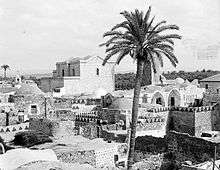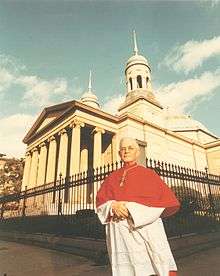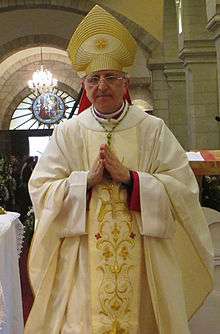Diocese of Lydda
The Diocese of Lydda is one of the oldest and most significant Bishoprics of the early Christian Church in the Holy Land, faded under Persian and Arab-Islamic rule, was revived by the Crusaders and remains a Latin Catholic titular see.

Founded in the 1st century, there has been a Bishop of Lydda continuously since.
Ancient history and bishopric
In early Christian times, Lydda (today El-Ludd (Arabic) or again Lod) was a prosperous Jewish town, located on the intersection of the North – South and the Egypt to Babylon roads, it was made wealthy on the trade that passed through it.
According to the Bible Lod was founded by Semed of the Israelite Tribe of Benjamin; Some of its inhabitants were led into Babylonian exile, part of them returned, but by mid second century, the king of Syria gave it to the Maccabees, who kept control until the arrival of Roman conqueror Pompei in Judea. Flavius Josephus confirms Julius Caesar gave it in 48 BC to the Hebrews, but Cassius sold the population in 44 BC, Marc Anthony released them two years later. The city saw Roman civil wars and Hebrew revolts in the first century, was officially renamed Diospolis, but remained popularly known as Lod or Lydda.
It harbored Christian since the Apostle Petrus preached there and cured the paralytic Eneas. It was a natural point to establish a church, which was already established when Saint Peter visited the city between 31–36AD.[1] By 120AD most of its inhabitants were Christian. The episcopal see was established allegedly by the first Byzantine emperor Constantin the Great, as suffragan of the Archdiocese of Caesarea in Palestina, in the sway of the original Patriarchate of Jerusalem. In December 415, the Council of Diospolis was held in the bishopric to try British monk Pelagius; he was acquitted but his heresy Pelagianism condemned. The earliest historically recorded bishop is Aëtius, a friend of Arius.
The city was renamed Georgiopolis after local martyr St George, patron saint of England was born in the town and buried on the site of the basilica of Georgius, first mentioned about 530 by pilgrim Theodosius.
It suffered gravely under pagan Persian border incursions and faded at the advent of Arab Muslims.
- Byzantine Suffragan Bishops of Lydda/ Diopolis/ Georgiopolis
- (according to tradition) Zenas the Lawyer
- Aëtius, a friend of Arius (fl. 325 - death before 335) [2][3]
- Dionysius (fl. 381 - death before 415)
- Photinus (fl. 449 - 451) [4]
- Apollonius (fl. 518)
- Eustatius
Latin Crusader bishopric
In 1099, during the triumphant First Crusade (1096–1099), Lydda and Arab neighbour town Ramla were assigned to Robert, a Norman known after his natal diocese Rouen (in Normandy, France, were conquering Vikings were christianized only a few generations), who was installed as virtual prince-bishop, wielding temporal feudal power as well as religious jurisdiction, obliged to supply a cavalry contingent to the Latin Kingdom of Jerusalem.
In 1110 civil jurisdiction over Ramla was spit off as a separate Lordship of Ramla, vested in Baldwin.
Saint George's church was burned by Muslim in 1099, but rebuild larger, shifted to the northeast, in the 12th century by the Crusaders as Latin cathedral, but again destroyed by Saracens in 1191, in the fight against English crusader king Richard Lionheart, the patron saint of both knighthood and England being of great significance to his troops.
- Latin Suffragan Bishops of Lydda
- Robert of Rouen c 1099[5][6]
- Bishop Roger fl. 1110 (Catholic)
- Constantinus (fl. 1154 - 1160)[10]
- Reinier = Ranierus (fl .1164 - death 1169)[
- Bernard(us) of Lydda (1168?69 – 1174?90)[7][8]
- Unknown Bishop of Lydda who spoke to king Richard I Lionheart in 1192.
- Isias (Orthodox bishop) fl.1202.
- Pelagius (? - 27 May 1227), next Bishop of Salamanca (Spain)
- Radulphus = Ralph I (menzionato nel 1232)
- Ralph of Lydda = Radulfo II † (fl 1238 - 1244) [9]
- Arnaldus (fl. 1250 - 1253)
- William (? - 8 May 1263), next vescovo di Agen (France)
- John Bishop of Lydda (before 1267 - after 1271)
- Godfrey (in 1286), ?Franciscan.
Titular Latin bishopric




As the Crusader kingdom fell to Saladin, Lydda was truly in partibus infidelium. From the 15th century, it was a Latin titular bishopric both under the names Lydda and Diospolis in Palaestina, with a messy proliferation of titular incumbents the next century with up to eleven titular bishops 'on' the see of Lydda.
- Titular Bishops of Lydda/ Diospolis
- BIOS TO ELABORATE
- Benedikt Sibenhirter, (20 Nov 1452 – 10 May 1458)[10]
- Thomas Lydensis (fl 1495)
- Nicolaus de Braciano, (29 April 1504 – 1509)
- Hermanus Nigenbroch, (7 Nov 1509 – 1511)
- Petrus Antonii (18 July 1511 – 1515)
- Heinrich von Hattingen (10 Dec 1515 - 1519)
- Giovanni Brainfort (26 Feb 1517 - 1521)
- Thomas Bele (7 June 1521 – 1524)
- Pompeo Musacchi (11 May 1524 – )
- Marcus Teggingeri (10 Dec 1568 – )
- Georges Scultetus (3 March 1603 -1613)
- Franz Weinhart (26 Feb 1663 – 22 June 1686)
- Francisco Varo (5 Feb 1687 – Did Not Take Effect)
- Giovanni Battista Bruni, (5 August 1765 – 21 Sep1771)
- Johann Baptist Joseph Gobel (27 Jan 1772 – 7 Nov 1793 Resigned)
- Anselmo Basilici (19 Dec 1814 – 25 May 1818)
- Francesco Pichi (25 May 1818 – 21 May 1827)
- Robert Gradwell (17 June 1828 – 15 March 1833)
- Henri Monnier (23 Feb 1872 – 28 Nov1916)
- Bernard Nicholas Ward [11] (22 March 1917 – 20 July 1917)
- Patrice Alexandre Chiasson (27 Jul 1917 – 9 Sep 1920)
- Michele Cerrati (15 Sep 1920 – 21 Feb 1925)
- John James Joseph Monaghan (10 July 1925 – 7 Jan 1935)
- William Richard Griffin (9 March 1935 – 18 March 1944)
- Girolamo Bartolomeo Bortignon (4 April 1944 – 9 Sep 1945)
- Lawrence Joseph Shehan (17 Nov 1945 – 25 August 1953)
- Frédéric Duc (11 Jan 1954 – 10 Dec 1970)
- Marcelino Sérgio Bicego (6 August 1971 – 26 May 1978)
- Jean-Baptiste Gourion, (14 August 2003 – 23 June 2005)
- William Hanna Shomali (31 March 2010 - ...)[12]
See also
- List of Catholic dioceses in Holy Land and Cyprus
- Diospolis (disambiguation) for namesakes, including three titular bishoprics (in Egypt and Thrace)
References
- ↑ Book of Acts, 9:32-35.
- ↑ Michel Le Quien, Oriens christianus, page 872.
- ↑ Patrum Nicaenorum nomina p13.
- ↑ Richard Price, Michael Gaddis, The Acts of the Council of Chalcedon, Volume 1 (Liverpool University Press, 2005) p360.
- ↑ Dr Marwan Nader, Burgesses and Burgess Law in the Latin Kingdoms of Jerusalem and Cyprus (1099–1325), p132
- ↑ Denys Pringle, The Churches of the Crusader Kingdom of Jerusalem: A Corpus: Volume 2, L-Z (excluding Tyre) (Cambridge University Press, 1993) p11.
- ↑ Malcolm Barber, The Crusader States (Yale University Press, 2012)
- ↑ Malcolm Barber, The Crusader States (Yale University Press, 2012)
- ↑ Kenneth Meyer Setton, Robert Lee Wolff, Harry W. Hazard, A History of the Crusades, Volume 2 (Univ of Wisconsin Press, 1969) p 536
- ↑ http://www.gcatholic.org/dioceses/former/t1021.htm
- ↑ The bishop of Lydda Consecration at Westminster cathedral The Tablet Page 14
- ↑ David M. Cheney, 1996–2016 Catholic hierarchy
Sources and external links
- GCatholic - (former and) titular see
- Sabino De Sandoli, Corpus Inscriptionum Crucesignatorum Terrae Sanctae, Jerusalem, Studium Biblicum Franciscanum, 1974.
- Michel Le Quien, Oriens christianus in quatuor patriarchatus digestus, in quo exhibentur Ecclesiae patriarchae caeterique praesules totius Orientis, Paris, Typographia regia, 1740, III, 581-8, 1271-6.
- Charles D. Du Cange, Nicolas Rodolphe Taranne; Emmanuel Guillaume Rey, Les familles d'outre-mer, Paris, Imprimerie Impériale, 1869, pp. 799-802.
- Hans Eberhard Mayer, The Origins of the Lordships of Ramla and Lydda in the Latin Kingdom of Jerusalem, in Speculum, vol. 60, nº 3, July 1985, pp. 537-552.
- Bruno Figliuolo, Chiesa e feudalità nei principati latini d'Oriente durante il XII secolo, in Pietro Zerbi (editor), Chiesa e mondo feudale nei secoli X-XII: atti della dodicesima settimana internazionale di studio Mendola, 24-28 agosto 1992, Vita e Pensiero, 1995, pp. 375-410, ISBN 978-88-343-1241-4.
- Victor Guérin, Chapitre III - Loudd, in Description géographique, historique et archéologique de la Palestine: Judée, Imprimerie impériale, 1868, pp. 322-334.
- Emil Schürer, Geschichte des jüdischen Volkes im Zeitalter Jesu Christi, J. C. Hinrichs, 1909, I e II, passim.
- Fulcran Vigouroux, Dictionnaire de la Bible, Parigi, Letouzey et Ané, 1895-1912.
- Gaetano Moroni, Dizionario di erudizione storico-ecclesiastica, vol. 38, pp. 195-197
- Pius Bonifacius Gams, Series episcoporum Ecclesiae Catholicae, Leipzig 1931, p. 453
- Konrad Eubel, Hierarchia Catholica Medii Aevi, vol. 1, p. 305; vol. 2, p. 144 e 177; vol. 3, pp. 225 e 344; vol. 4, p. 221; vol. 5, p. 251; vol. 6, p. 270